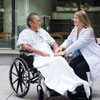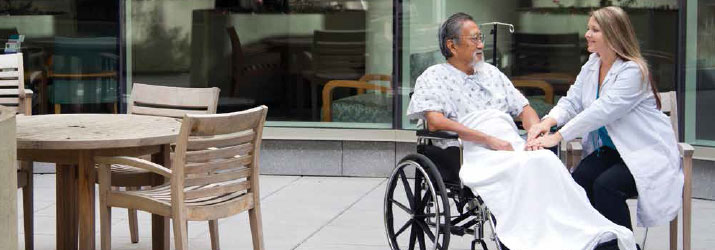
Operating with an Aggressive Dose of Security
CentraCare Health System takes a multi-pronged approach to medical safety and patient care
- By Fredrik Nilsson
- Apr 01, 2013

Four hospitals (St. Cloud, Long Prairie, Melrose and Sauk Centre),
five long-term care facilities, nearly a dozen clinics and numerous
specialty services operate under the growing CentraCare Health System
umbrella in central Minnesota. In the past four years, Centra-
Care’s growth has skyrocketed, and so, too, has the need to upgrade
its security systems.
CentraCare’s security department has been working hard to coordinate safety
and security measures at all of its locations. Faced with a variety of legacy analog
cameras and DVRs, an aging access control system and difficult-to-secure narcotics
cabinets, the collaborative healthcare group began searching for new technologies
to help maintain central oversight of its increasing number of facilities and
mitigate risks to patients and staff.
This search led CentraCare to Pro-Tec Design, a PSA Security Network owner
and security system integrator based in Minneapolis. Together, they embarked on
a multi-year, multi-pronged project that started with replacing the old access control
system while shoring up narcotics supervision by integrating IP video, and
ended with the hospital’s security team discovering new and innovative uses for
their IP security system from the ambulance bays to the ER to the helipad.
Suturing Security Holes
As more medical facilities were brought under the CentraCare name, disparate
systems and old technologies between the different properties were raising internal
concerns about potential risk and liability. Some facilities used DVR-based,
analog surveillance systems. Some relied solely on the presence of security staff. In
either case, there was no way for CentraCare to integrate surveillance between the
sites or centrally monitor the cameras.
Surveillance wasn’t initially top of mind, however. Access control was CentraCare’s
first priority. While many of the facilities used magnetic card readers
to restrict employee and public access, it was questionable whether it would be
cost effective to expand that system as the number of CentraCare acquisitions
continued to grow. All the facilities that housed controlled substances used standard
key-entry medicine cabinets. While it required two, separate keys to open a cabinet, duplicate keys had been made
and remade over the years, so without
an integrated video system, there was
no way to monitor who was actually
using them.
With the help of Pro-Tec, CentraCare began a systematic upgrade of
its security systems across its growing
number of facilities.
“[CentraCare] initially called us in
to replace their old card reader system,”
said Tim Ferrian, director of sales
and marketing for Pro-Tec Design.
“With all their acquisitions, expanding
the existing system would have been
cost-prohibitive.”
Pro-Tec recommended Lenel On-
Guard, a more scalable, IP-based access
control system that could be easily
managed over the health system’s
network. In addition, CentraCare also
began rolling out new drug lockers that
could only be opened by authorized
hospital staff swiping new ID cards.
“We eliminated the two-key system,
but the solution wasn’t foolproof yet,”
said Bill Becker, director of safety and
security for CentraCare Health System.
“Someone could still borrow someone
else’s ID to get into the locker.”
This led the security conversation
toward video surveillance, and what
CentraCare could do with IP-based
technology to verify who was really
swiping the ID card.
“We’ve now adopted a redundant,
cross-reference approach to controlling
access to narcotics,” Becker said. “Not
only is Pro-Tec Design installing card
readers on every new drug locker, they’re
flush-mounting miniature network cameras
in the dropped ceilings to record
who’s actually opening the locker.”
Originally, Pro-Tec installed fixed-dome
network cameras from Axis
Communications and leveraged privacy
masking in Milestone XProtect VMS
to ensure that only the locker was seen
on video and not the rest of a patient’s
room. Today, they have moved toward
pinhole-sized and HDTV-quality AXIS
P12 Network Cameras that are narrowly
focused solely on the drug lockers.
Following the success of the narcotics
monitoring solution, CentraCare
extended this two-part, access control/
video strategy to other sensitive areas
in the hospitals and clinics, including
the pharmacies, human resource offices
and other high, security-risk locations.
“Coupling these network cameras
with access control has become
the standard of care for CentraCare,”
Becker said.
When CentraCare first decided to
expand its surveillance project, Pro-Tec
attached video encoders to existing,
analog cameras to digitize the video
streams and connect to the network
that ran back to the main security office
in St. Cloud Hospital. Since then,
a majority of the legacy cameras have
been replaced by more-advanced, high resolution
network cameras.
Today, more than 300 surveillance
cameras keep watch over CentraCare
properties, stretching hundreds of
miles across central Minnesota. Only a
handful of the original analog cameras,
now network-enabled with encoders,
are still in place. All the cameras are
managed through Milestone XProtect
video management software from the health system’s security center.
“Because CentraCare runs fiber between most of
their facilities, we’re able to stream the video back to
St. Cloud’s security center for storage,” Ferrian said.
“Where the pipeline is too small, we record and store
the video locally. The security director and his team
can still view live and recorded video from all the
cameras in the system.”
CentraCare currently has about 108 terabytes
of total raw storage across the system residing on
Pivot3 servers.
“Every year we add more storage,” Ferrian said.
“And, every year they find more places where cameras
would be useful that are going to need that storage.”
Expanding from Risk Management to Patient Care
While risk management might have been the initial
impetus for tightening security, CentraCare continues
to broaden its use of network surveillance cameras to
include other areas of its operation. Today, Becker’s
security team uses the IP cameras on a daily basis to
help the medical staff improve safety and patient care.
For instance, security uses HDTV-quality IP cameras
to keep an eye on high-risk patients in the emergency
and psychiatric evaluation rooms. If an officer
watching the video monitor observes a patient growing
restless or agitated, they will immediately enter the
room to keep the patient from falling off the cart or
becoming unruly. The XProtect Smart Client interface
allows security to see multiple views at a time,
saving the cost of stationing an officer in every room.
“In keeping with HIPAA regulations and our own
privacy and confidentiality policies, we don’t record the
video in those rooms. We only view it live,” Becker said.
In addition to more traditional locations for video
surveillance, such as front entrances, gift shops and
food service operations, CentraCare security uses
fixed dome network cameras with audio recording
capability to monitor their weapons screening area.
Security checks everyone entering the building for
firearms and other potentially harmful objects.
“Being able to compare what’s being said with what
you’re seeing clearly on the screen, helps us in addressing
complaints against our officers,” Becker said.
He recalled one person who accused a CentraCare officer of being rude, patting him down inappropriately
and then stealing his cellphone. When
Becker offered to show the accuser the recorded
video of the alleged incident, the complaint immediately
evaporated.
Responding to Emergency Fly-ins and Drive-ins
Pro-Tec Design also installed vandal-resistant and
weather-proof fixed domes on St. Cloud’s helipad
and in the ambulance bay. Becker explains that the
cameras serve a dual purpose: to expedite the dispatch
of medical personnel and to keep the transport
areas safe. The exceptional light sensitivity of the IP
cameras make them a good fit for the variable lighting
conditions in these outdoor locations because the
day/night and wide dynamic range functionalities deliver
crisp images around the clock.
CentraCare authorizes Life Link III, its air ambulance
service, to monitor the helipad camera from
their own dispatch center to make sure they’re not directing
one of their helicopters to an occupied pad.
“It’s a good safety catch,” Becker said.
For added protection, Becker always assigns an
officer to the helipad, when a helicopter is scheduled
to land. That officer is required to maintain constant
radio contact with the air service. CentraCare is using
this surveillance strategy for the helipads at the Melrose
and Sauk Centre Hospitals, as well.
From surveillance stations in the emergency trauma
center, security also monitors activity in the ambulance
bay, a fast-paced hub of activity that can hold up to
as many as six ambulances at a time. Because the IP
cameras support audio, Becker’s team has both eyes
and ears on the situation to determine if the arrival
is a medically, high-risk patient who needs additional
emergency staff attention or if a problem patient has
arrived and the presence of a security officer is needed.
Protecting the NICU, PICU and Birthing Rooms
The more CentraCare familiarizes itself with the IP
surveillance system, the more opportunities seem to
arise. For instance, CentraCare has most recently deployed
IP cameras along the third floor hallways of
St. Cloud Hospital to monitor foot traffic. Coverage
of this area was a priority, since the ward houses newborns,
infants and mothers.
Because hallway lights are dimmed at night for
patient comfort, it was important to install cameras
that could deliver clear video in lowlight conditions.
Almost immediately after installing new Axis fixed
domes, security was able to use the digital PTZ and
highly light-sensitive Lightfinder capabilities to track,
and ultimately catch, a thief as he passed through the
ward. As an added precaution, the healthcare system
has long-range plans to install the same cameras inside
the neonatal and premature infant care units and
the birthing rooms.
While CentraCare staff remains dedicated to respecting
the privacy of their patients, they continue
to apply an aggressive dose of surveillance to all their
facilities to ensure the safety and security of their patients
and staff. According to Becker, the pushback
from patients has been nearly nonexistent and CentraCare
staff has welcomed the step up in security.
“Our employees firmly believe that the cameras
and microphones are there for their protection,” he
said.
This article originally appeared in the April 2013 issue of Security Today.